Lyons W.C. (ed.). Standard handbook of petroleum and natural gas engineering.2001- Volume 1
Подождите немного. Документ загружается.

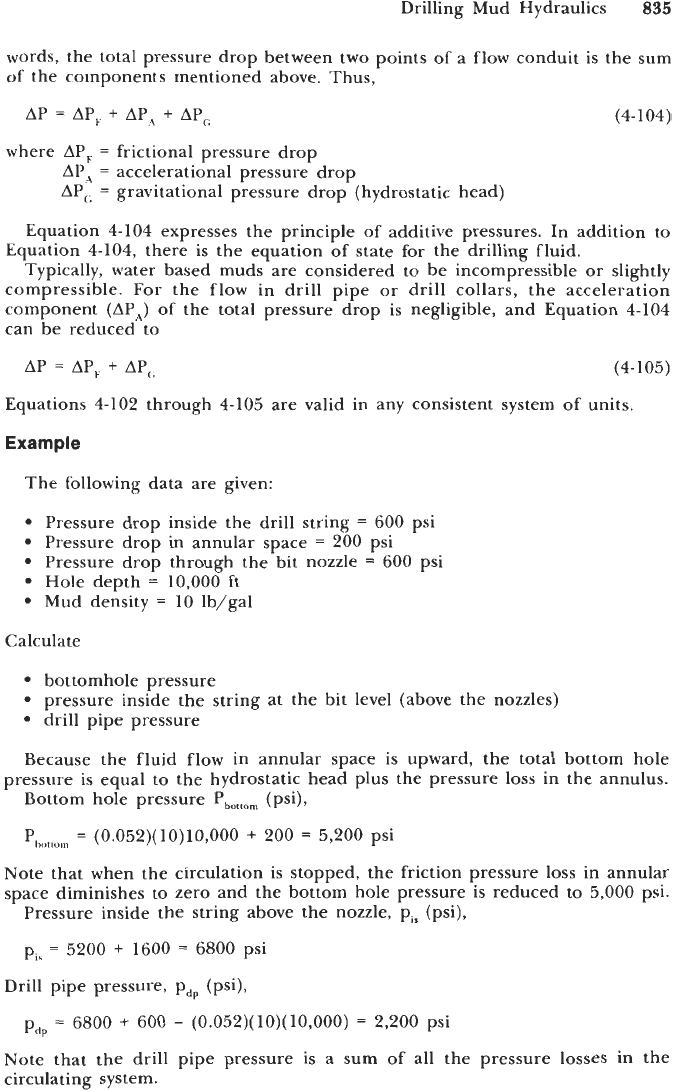
Drilling Mud Hydraulics
835
words, the total pressure drop between two points of a flow conduit is the sum
of the components mentioned above. Thus,
AP
=
AP)
+
AP4
+
AP,
(4- 104)
where APF
=
frictional pressure drop
APa
=
accelerational pressure drop
AP,
=
gravitational pressure drop (hydrostatic head)
Equation 4-104 expresses the principle of additive pressures. In addition
to
Equation 4-104, there is the equation of state for the drilling fluid.
Typically, water based muds are considered to be incompressible or slightly
compressible. For the flow in drill pipe or drill collars, the acceleration
component (AP,) of the total pressure drop
is
negligible, and Equation 4-104
can be reduced to
AP
=
APk
+
APc,
(4-1
05)
Equations 4-102 through 4-105 are valid in any consistent system of units.
Example
The following data are given:
Pressure drop inside the drill string
=
600 psi
Pressure drop in annular space
=
200 psi
Pressure drop through the bit nozzle
=
600
psi
Hole depth
=
10,000 ft
Mud density
=
10 lb/gal
Calculate
bottomhole pressure
pressure inside the string at the bit level (above the nozzles)
drill pipe pressure
Because the fluid flow in annular space is upward, the total bottom hole
pressure is equal to the hydrostatic head plus the pressure loss in the annulus.
Bottom hole pressure
Photlom
(psi),
Ph<,L,o,n
=
(0.052)(10)10,000
+
200
=
5,200
psi
Note that when the circulation is stopped, the friction pressure loss in annular
space diminishes
to
zero and the bottom hole pressure is reduced to
5,000
psi.
Pressure inside the string above the nozzle, pi, (psi),
p,,
=
5200
+
1600
=
6800
psi
Drill pipe pressure,
pdp
(psi),
pa,
=
6800
+
600
-
(0.052)(10)(10,000)
=
2,200 psi
Note that the drill pipe pressure is a
sum
of
all the pressure losses in the
circulating system.

836
Drilling and Well Completions
Frlction Pressure
Loss
Calculations
Laminar Flow
For pipe flow of Bingham plastic type drilling fluid, the following can be used:
FLV
ZL
Ap
=
P
+y
1500d' 225d
Corresponding equation for a Power law type drilling fluid
is
AP
=
[
(?)(
$31
"KL
(4-1
06)
(4-
107)
For annular flow of Bingham plastic and Power law fluids, respectively,
Ap
=
FPLV
+
ZYL
1000(d,
-
d,)' 200(d,
-
d,)
and
Ap
=
[(
2.4v
](%)I"
KL
300(
d,
-
d,
)
(d,
-4)
(4-108)
(4-109)
Turbulent Flow
Turbulent flow occurs if the Reynolds number as calculated above exceeds a
certain critical value. Instead
of
calculating the Reynolds number, a critical flow
velocity may be calculated and compared to the actual average flow velocity [60].
The critical velocities for the Bingham plastic and Power law fluids can be
calculated as follows:
Bingham plastic fluid
1.08~~
+l.OSJp;
+9.256(d, -d,)'Zyp
v,
=
(dl
-4)
Power law fluid
(4-110)
(4-111)
In the case of pipe flow, for practical purposes, the corresponding critical
velocities may be calculated using Equation 4-110 and 4-111, but letting d,
=
0.
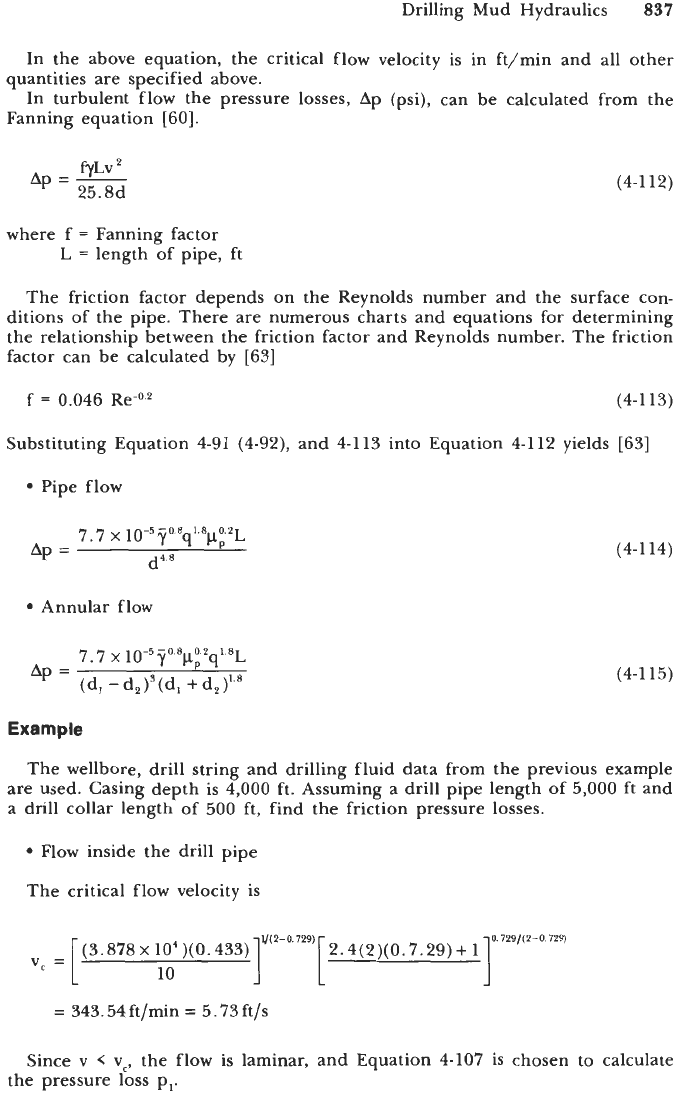
Drilling Mud Hydraulics
837
In the above equation, the critical flow velocity is in ft/min and all other
In turbulent flow the pressure losses, Ap (psi), can be calculated from the
quantities are specified above.
Fanning equation
[60].
QLV
Ap
=
-
25.8d
(4-112)
where
f
=
Fanning factor
L
=
length of pipe,
ft
The friction factor depends on the Reynolds number and the surface con-
ditions of the pipe. There are numerous charts and equations for determining
the relationship between the friction factor and Reynolds number. The friction
factor can be calculated by
[63]
f
=
0.046
Re-0.2
(4-113)
Substituting Equation
4-91 (4-92),
and
4-113
into Equation
4-112
yields
[63]
Pipe flow
7.7
x
10-5708q1.8,43
Ap
=
d4.8
Annular flow
7.7
x
10-~
yo.8p;2q1.8L
Ap
=
(d,
-
d,)’(d,
+
d2)1.8
(4-114)
(4-115)
Example
The wellbore, drill string and drilling fluid data from the previous example
are used. Casing depth is
4,000
ft. Assuming a drill pipe length of
5,000
ft and
a drill collar length of
500
ft, find the friction pressure losses.
Flow inside the drill pipe
The critical flow velocity is
0.729/(2-0.729)
1
1/(2-0.729)
(3.878~ 1o4)(0.433) 2.4(2)(0.7.29)
+
1
vc
=[
10
=
343.54
ft/min
=
5.73
ft/s
Since
v
<
vc,
the flow is laminar, and Equation
4-107
is chosen to calculate
the pressure loss pl.
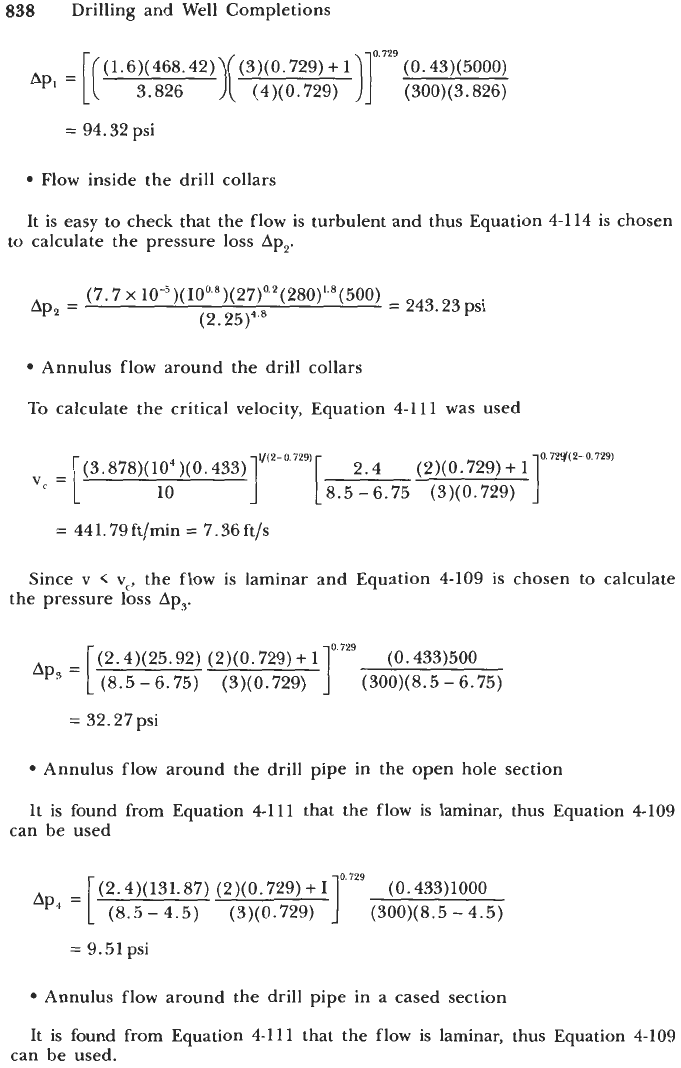
838
Drilling and Well Completions
(0.43)(
5000)
(300)( 3.826)
Ap,
=
[(
(1.6)(468.42) (3)(0.729)+1
3.826
)(
(4NO.729)
=
94.32
psi
Flow inside the drill collars
It is easy to check that the flow is turbulent and thus Equation
4-114
is chosen
to calculate the pressure loss Ap2.
(7.7
x
10~5)(100~8)(27)0~2(280)'~8(500)
=
243.23psi
(2. 25)4.8
AP2
=
Annulus flow around the drill collars
To
calculate the critical velocity, Equation
4-1 11
was used
]
I/(%
0.729)
[
2.4 (2)(0.729)+1]
0.721y(2-0.729)
(3.878)(
lo4
)(O.
433)
vc=[
10 8.5 -6.75 (3)(0.729)
=
441.79ftJmin
=
7.36ftJs
Since
v
<
vc,
the flow is laminar and Equation
4-109
is chosen to calculate
the pressure loss Ap,.
0.729
(0.433)500
1
(300)(8.5
-
6.75)
[
(2.4)(25.92) (2)(0.729)+
1
*"
=
(8.5-6.75) (3)(0.729)
=
32.27
psi
Annulus flow around the drill pipe in the open hole section
It is found from Equation
4-111
that the flow is laminar, thus Equation
4109
can be used
0.729
(0.433)lOOO
(300)(8.5
-
4.5)
[
(2.4)( 131.87) (2)(0.729)
+
1
=
(8.5
-
4.5) (3)(0.729)
=
9.51
psi
Annulus flow around the drill pipe in a cased section
It
is found from Equation
4-111
that the flow is laminar, thus Equation
4-109
can be used.
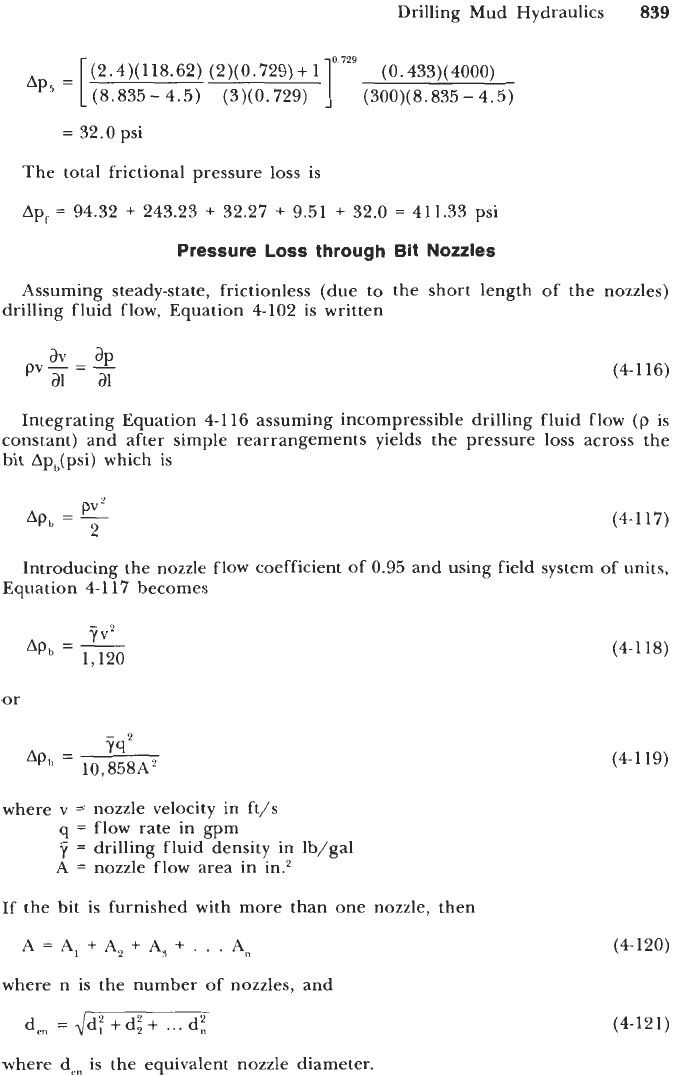
Drilling Mud Hydraulics
839
0.729
(2.4)(118.62) (2)(0.729)+
1
]
(0.433)(
4000)
(8.835- 4.5) (3)(0.729) (300)(8.835- 4.5)
AP5
=
[
=
32.0
psi
The total frictional pressure loss
is
Apf
=
94.32
+
243.23
+
32.27
+
9.51
+
32.0
=
411.33
psi
Pressure
Loss
through
Bit
Nozzles
Assuming steady-state, frictionless (due to the short length of the nozzles)
drilling fluid flow, Equation
4-102
is written
av
ap
ai
ai
pv-
=
-
(4-1 16)
Integrating Equation
4-1 16
assuming incompressible drilling fluid flow
(p
is
constant) and after simple rearrangements yields the pressure
loss
across the
bit Ap,(psi) which is
pvp
b2
Ap
=
-
(4-117)
Introducing the nozzle flow coefficient of
0.95
and using field system
of
units,
Equation
4-1
17
becomes
7VZ
AP,,
=
-
1,120
or
7q2
=
10, 858A2
where
v
=
nozzle velocity in ft/s
q
=
flow rate in gpm
7
=
drilling fluid density in lb/gal
A
=
nozzle flow area in in.2
If the bit
is
furnished with more than one nozzle, then
where n
is
the number of nozzles, and
den
=dd;+di+
...
dz
where
den
is the equivalent nozzle diameter.
(4-118)
(4-1
19)
(4- 120)
(4-12
1)

840
Drilling and Well Completions
Example
A tricone roller rock bit is furnished with three nozzles with the diameters
of
-&,
+!j
and
$j
in. Calculate the bit pressure drop if the mud weight is
10
Ib/gal
and flowrate is
300
gpm.
Nozzle equivalent diameter is
d,,
=
1-
=
0.5643
in.
and the corresponding flow area is
The pressure loss through bit nozzles is
AIR AND GAS DRILLING
Types
of
Operations
Air and natural gas have been used as drilling fluids to drill oil and gas wells
since
1953.
There are basically four distinct types of drilling using these fluids:
air and gas drilling with no additives (often called dusting), unstable foam
drilling (also called misting), stable foam drilling and aerated mud drilling
[64].
Air and natural gas have also been used as drilling fluids in slim-hole-drilling
mining operations, special large-diameter boreholes for nuclear weapons tests,
and, more recently, in geothermal drilling operations.
Air and natural gas drilling techniques are used principally because of their
ability to drill in loss-of-circulation areas where mud drilling operations are
difficult or impossible. These drilling fluids have other specific advantages over
mud drilling fluids when applied to oil and gas well drilling operations, which
will be discussed later in this section. In general, air and gas drilling techniques
are restricted to mature sedimentary basins where the rock formations are well
cemented and exhibit little plastic flow characteristics. Also, to varying degrees,
air and gas drilling techniques are restricted to drilling in rock formations that
have limited formation water or other fluids present.
In the United States, air and gas drilling techniques are used extensively in
parts of the southwest in and around the San Juan Basin, in parts
of
the Permian
Basin, in Arkansas and eastern Oklahoma, in Maryland, Virginia and parts
of
Tennessee. Internationally, oil and gas drilling operations are carried out with
air and gas drilling techniques in parts of the Middle East, North Africa and
in the Western Pacific.
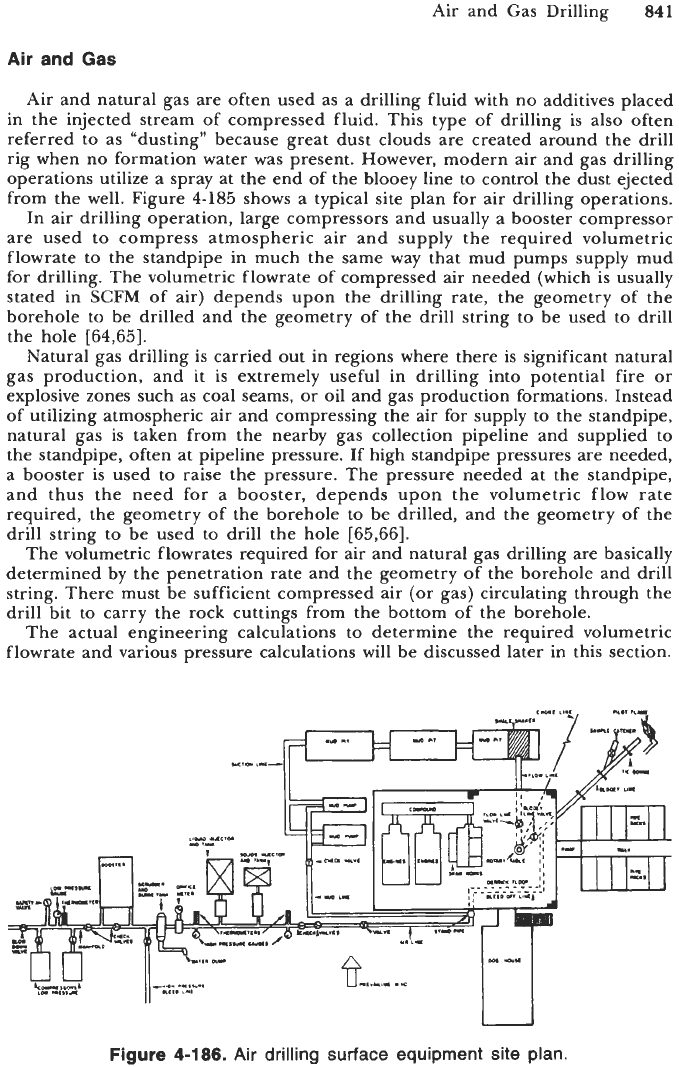
Air and Gas Drilling
841
Air
and
Gas
Air and natural gas are often used as a drilling fluid with no additives placed
in the injected stream of compressed fluid. This type
of
drilling is also often
referred to as “dusting” because great dust clouds are created around the drill
rig when no formation water was present. However, modern air and gas drilling
operations utilize a spray at the end
of
the blooey line to control the dust ejected
from the well. Figure
4-185
shows a typical site plan for air drilling operations.
In
air drilling operation, large compressors and usually a booster compressor
are used to compress atmospheric air and supply the required volumetric
flowrate to the standpipe in much the same way that mud pumps supply mud
for drilling. The volumetric flowrate
of
compressed air needed (which is usually
stated in
SCFM
of air) depends upon the drilling rate, the geometry of the
borehole to be drilled and the geometry of the drill string to be used to drill
the hole
[64,65].
Natural gas drilling is carried out in regions where there is significant natural
gas production, and it is extremely useful in drilling into potential fire or
explosive zones such as coal seams, or oil and gas production formations. Instead
of utilizing atmospheric air and compressing the air for supply to the standpipe,
natural gas is taken from the nearby gas collection pipeline and supplied to
the standpipe, often at pipeline pressure. If high standpipe pressures are needed,
a booster
is
used to raise the pressure. The pressure needed at the standpipe,
and thus the need for a booster, depends upon the volumetric flow rate
required, the geometry of the borehole to be drilled, and the geometry
of
the
drill string to be used to drill the hole
[65,66].
The volumetric flowrates required for air and natural gas drilling
are
basically
determined by the penetration rate and the geometry
of
the borehole and drill
string. There must be sufficient compressed air
(or
gas) circulating through the
drill bit to carry the rock cuttings from the bottom of the borehole.
The actual engineering calculations to determine the required volumetric
f lowrate and various pressure calculations will be discussed later in this section.
Figure
4-1
86.
Air
drilling surface equipment site plan.

842
Drilling
and
Well Completions
Unstable Foam (Mist)
In order to increase the formation water-carrying capacity of the air and
natural gas drilling fluids, water is often injected at
the
surface just after the
air has been compressed and prior to the standpipe (water injector
is
shown in
Figure
4-186).
An amount of water is injected that will saturate the compressed air
when it reaches the bottom of the hole. Thus, if the water-saturated returning
airflow encounters formation water, internal energy in the airflow will not be
required to change the formation water to vapor. The formation water will be carried
to the surface as water particles much like the
rock
cuttings. If only water is injected
at the surface, then the drilling fluid is called “mist.” Usually a surfactant is injected
with the injected water. This surfactant will cause the air and water to foam. This
foam, however, is not continuous (Le., it will have large voids in the annulus section
because of the high velocity of the returning airflow). This is the reason why this
type of drilling operation is also denoted as unstable foam.
Stable
Foam
Stable foam drilling operations are used when even more formation water-
carrying capability is needed (relative to air
and
gas and unstable foam). Also,
stable foam provides significant bottomhole pressure that can counter formation
pore pressures and thus provide some well control capabilities. Stable foam
drilling operations provide a continuous column of foam in the annulus from
the bottom of the borehole annulus to the back pressure valve at the end of
the blooey line. Air and natural gas and unstable foam require large compressors
to produce a fixed volumetric flowrate of air. Stable foam drilling requires far
less compressed air, and the compressed air is provided by a flexible system.
The air compressors used in stable foam drilling should be capable of supplying
air at various pressures and volumetric flowrates. In general, the back pressure
valve at the end of the blooey line is adjusted to ensure that a continuous foam
column exists in the annulus. However, if the back pressure is too high, the foam
at the bottom of the borehole (in the annulus) will break down into the indi-
vidual phases of liquid and gas. Foam quality at the bottom hole in the annulus
should not drop below about
60%
[67-691.
Engineering calculations for deter-
mining the appropriate parameters for stable foam drilling operations
are
quite
complicated. There
are
a
few stable foam simulation programs available for well
planning
[70].
Those interested in stable foam engineering calculations are
advised to consult service companies specializing in stable foam drilling operations.
Aerated Mud
Aerated mud drilling operations are used throughout the drilling industry,
onshore and offshore. Aerated mud drilling is usually employed as an initial
remedy to loss-of-circulation problems. To aerate water-based mud
or
oil-based
mud, air is injected into the drilling mud flow at the surface prior to the mud
entering the standpipe (primary aeration)
or
in the return annulus flow through
an air line set with the casing string (parasite tubing aeration)
[71,72].
Primary
aeration is the most commonly used technique for aerating mud. But because
of the high resistance to flow
of
aerated liquids, as aeration
is
needed at depth,
parasite tubing aeration offers a usable alternative.
The relative advantages
and
disadvantages
of
the various types of
air
and
gas
drilling operations discussed are listed as follows:

Air and Gas Drilling
843
Air and Gas (Dusting)
Advantages Disadvantages
No
loss-of-circulation problem
No
formation damage
Very high penetration rate
Low bit costs
Low water requirement
No
mud requirement
No
ability to counter subsurface pore
Little ability to carry formation water
Hole erosion problems are possible
if
Possible drill string erosion problems
Downhole fires are possible
if
hydro-
carbons are encountered (gas only)
Specialized equipment necessary
pressure problems
from hole
formations are
soft
~ ~ ~
Unstable Foam (Mlsting)
Advantages
No loss-of-circulation problem
Ability to handle some formation water
No
formation damage
Very high penetration rate
Low bit costs
Low water requirement
No
mud requirement
Low chemical additive costs
Downhole fires are normally not a
problem even with air
Disadvantages
Very little ability to counter subsurface
No
ability to carry a great deal
of
Hole erosion problems are possible
if
Possible drill string erosion problems
Specialized equipment necessary
pore pressure problems
formation water from hole
formations are
soft
Stable Foam
Advantages Dlsadvantages
No
loss-of-circulation problem
Ability to handle considerable forma-
Little or no formation damage
High penetration rate
Low bit costs
Low water requirements
No
mud requirements
Some ability to counter subsurface
Considerable additive (foamer) costs
Careful and continuous adjusting
of
Specialized equipment necessary
tion water proportions necessary
pore pressure problems
Aerated Mud
Advantages Disadvantages
Loss
of circulation is not a big
Ability to handle very high volumes of
High mud pump pressure requirements
High casinglair line costs
if
parasite
Some specialized equipment
problem
formation water
tubing is used
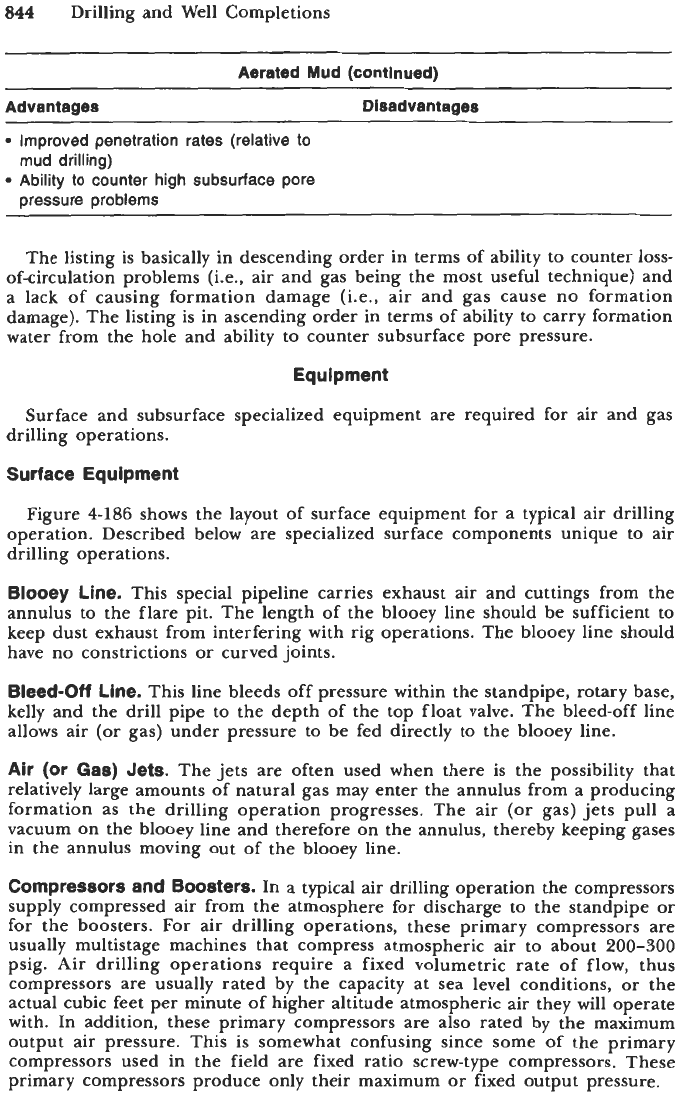
844
Drilling and Well Completions
~~~~~
Aerated Mud (continued)
Advantages
Disadvantages
Improved penetration rates (relative to
Ability
to
counter high subsurface pore
mud drilling)
Dressure Droblems
The listing is basically in descending order in terms of ability to counter loss-
of-circulation problems (i.e., air and gas being the most useful technique)
and
a
lack of causing formation damage (Le., air and gas cause no formation
damage). The listing is in ascending order in terms of ability to carry formation
water from the hole and ability to counter subsurface pore pressure.
Equipment
Surface and subsurface specialized equipment are required for air and gas
drilling operations.
Surface Equipment
Figure
4186
shows the layout of surface equipment for a typical air drilling
operation. Described below are specialized surface components unique to air
drilling operations.
Blooey Line.
This special pipeline carries exhaust air and cuttings from the
annulus to the flare pit. The length of the blooey line should be sufficient to
keep dust exhaust from interfering with rig operations. The blooey line should
have no constrictions
or
curved joints.
Bleed-Off Line.
This line bleeds off pressure within the standpipe, rotary base,
kelly and the drill pipe to the depth of the top float valve. The bleed-off line
allows air
(or
gas) under pressure to be fed directly to the blooey line.
Air (or Gas) Jets.
The jets are often used when there is the possibility that
relatively large amounts of natural gas may enter the annulus from a producing
formation as the drilling operation progresses. The air
(or
gas) jets pull a
vacuum on the blooey line and therefore on the annulus, thereby keeping gases
in the annulus moving out of the blooey line.
Compressors and Boosters.
In a typical air drilling operation
the
compressors
supply compressed air from the atmosphere for discharge
to
the standpipe or
for the boosters.
For
air drilling operations, these primary compressors are
usually multistage machines that compress atmospheric air to about
200-300
psig. Air drilling operations require a fixed volumetric rate of flow, thus
compressors are usually rated by the capacity at sea level conditions, or the
actual cubic feet per minute of higher altitude atmospheric air they will operate
with. In addition, these primary compressors are also rated by the maximum
output air pressure. This is somewhat confusing since some of the primary
compressors used in the field are fixed ratio screw-type compressors. These
primary compressors produce only their maximum
or
fixed output pressure.
